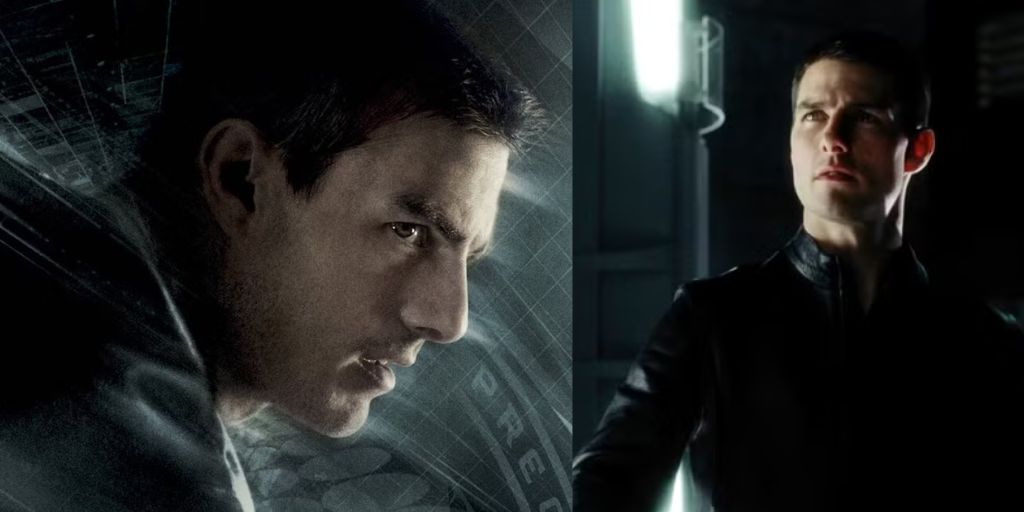
Steven Spielberg’s Minority Report is one of the most thought-provoking science fiction thrillers ever made. Based on Philip K. Dick’s short story of the same name, the film questions fate, justice, and the delicate concept of free will.
Released in 2002, it stars Tom Cruise as Chief John Anderton, a man working for an experimental police unit called PreCrime, which prevents murders before they occur using psychic individuals known as Precogs.
While the movie holds an action-packed and suspenseful core, its conclusion stands as the heart of the narrative. The ending not only closes Anderton’s personal arc but also dismantles the foundation of a justice system built on questionable morality.
Let’s look closely at how the plot unravels in its final act, what revelations carry through to the characters, and the ultimate meaning of the conclusion.
Also Read: Kung Fu Panda 3 Ending Explained: Po Becomes True Master
The Setup to the Finale
Before the ending, Anderton discovers shocking truths that threaten both his life and the credibility of PreCrime. Throughout the film, he is accused of a future murder, forcing him to flee from the system he once protected.
His struggle leads him to Agatha, one of the Precogs, who tells him that minority reports (alternate visions of the future differing from the dominant prediction) exist. These reports prove that the future isn’t absolute, meaning people can change their destiny through choice.
The revelation shakes the foundation of PreCrime because the entire department relies on one unshakable assumption: that the future is pre-determined. If minority reports exist, it shows that people retain free will and should not be punished for crimes they haven’t actually committed.
This realization sets the stage for the climax involving Anderton, the PreCrime system, and one hidden figure pulling strings from behind the curtain.
The Confrontation with Lamar Burgess
The dramatic conclusion centers around Lamar Burgess, the director of PreCrime and mentor to Anderton. For much of the movie, Burgess seems like an honorable man who supports the program as a way to make Washington, D.C. murder-free. However, the truth reveals otherwise.
Anderton learns that Burgess had manipulated the system years earlier to hide his own murder of Anne Lively, Agatha’s mother. Lively threatened to take her daughter back, which would have dismantled PreCrime’s foundation.
To protect the project and his ambitions, Burgess orchestrated her murder in a way that would avoid detection. He staged it as a “red ball” crime, masking it under previsions and preventing suspicion.
The biggest twist comes when Anderton presents the recorded evidence of Burgess’s crime during a public gathering. He proves that PreCrime, which claimed to be flawless, was subject to corruption and human manipulation. The program itself could be exploited, revealing its inherent weakness.
The Climax: The Gun and the Choice
One of the most memorable sequences in the film is Burgess’s moral dilemma with the gun. The system predicts that Burgess will kill Anderton, meaning the “red ball” scenario (a premeditated murder vision) has been set. However, Anderton confronts him by explaining the paradox:
-
If Burgess kills Anderton, then PreCrime’s claim of perfection collapses because the director himself committed the crime it was designed to prevent.
-
If Burgess spares Anderton, then PreCrime is still finished, since the vision shows that the system isn’t absolute and the future can be altered.
It’s a scenario where Burgess cannot come out victorious, no matter what. Ultimately, Burgess chooses neither outcome that secures his position. Rather than kill Anderton or submit to trial, Burgess turns the gun on himself and commits suicide. This act ends the debate with one clear and haunting conclusion: PreCrime is fatally flawed.
Aftermath and the Fall of PreCrime
With Burgess gone and the hypocrisy of the system exposed, PreCrime is officially shut down. The government acknowledges that punishing people for crimes they might commit strips them of free will and denies the possibility of choice.

All individuals who were imprisoned in the system are released, marking the end of an experiment that seemed perfect on the surface but was destructive at its core.
This decision echoes the film’s philosophical question: if our future is predicted, are we still free? By ending PreCrime, society accepts the imperfections of human choice rather than the illusion of a flawless but unjust system.
John Anderton’s Closure
For Anderton, the ending carries a personal resolution. At the start of the movie, he is broken by the grief of losing his son, which leads to his dependency on drugs and obsession with the PreCrime project.
By the finale, however, Anderton reconciles his past with his wife Lara, who reunites with him after everything comes to light.
In the last scenes, Lara is pregnant once again, symbolizing hope and a new beginning for Anderton’s family. His personal victory mirrors the larger story: life is not determined by inevitabilities but shaped by choices, growth, and resilience.
The Fate of the Precogs
Another key element of the ending focuses on Agatha and the two precogs, Arthur and Dashiell. After the collapse of PreCrime, these individuals are given freedom and sanctuary in a remote countryside location. Having spent their lives exploited as tools of justice, they finally experience peace, away from visions of constant violence.
Their liberation underscores Spielberg’s central message: human beings should never be imprisoned by others’ agendas or stripped of their autonomy. Just like society received back its freedom, the Precogs are no longer bound by their roles as unwilling visionaries.
Themes Carried in the Ending
Several layered themes resonate through the conclusion of Minority Report.
-
Free Will versus Determinism: The ending demonstrates that the future is not a guaranteed outcome but a possibility influenced by choice. Anderton’s survival proves the Precogs cannot dictate absolute destiny.
-
Corruption of Power: Burgess’s deception shows how systems, no matter how advanced, remain vulnerable to human ambition and personal gain. The technology wasn’t inherently evil, but those in authority manipulated it for self-preservation.
-
Justice and Morality: The idea of punishing someone for a crime they haven’t yet committed is portrayed as fundamentally unjust. The victory lies not only in dismantling PreCrime but also in restoring moral responsibility to individuals.
-
Hope and Renewal: The final scenes with Anderton’s family and the peaceful lives of the Precogs bring closure. Humanity is given a second chance to grow by embracing its flaws rather than hiding them behind false promises of perfection.
The ending of Minority Report brings together tension, philosophy, and emotional closure in a way that still sparks conversation decades later. Instead of a simple story about futuristic crime prevention, it becomes a meditation on whether we are governed by fate or free to choose our path.
Anderton’s journey, Burgess’s downfall, and the liberation of the Precogs all contribute to a resolution that rejects determinism and embraces human freedom. By abolishing PreCrime, society acknowledges a universal truth: the possibility of choice is what defines humanity, not the rigid certainty of foreseen futures.
Also Read: Turning Red Ending Explained, Embracing Every Part of Yourself








